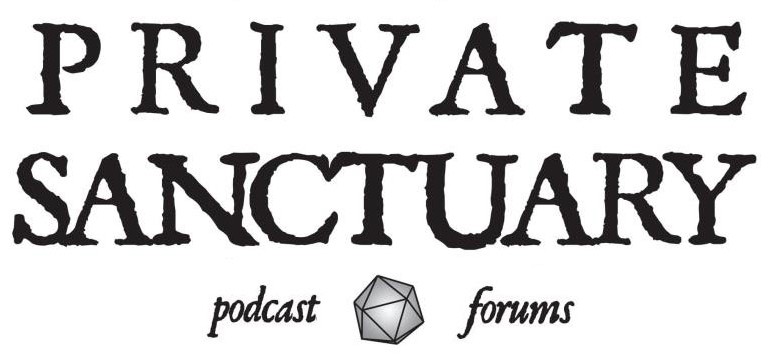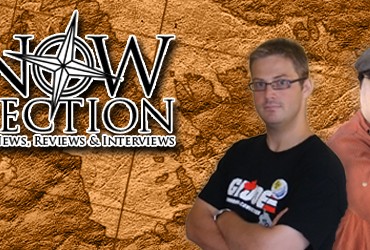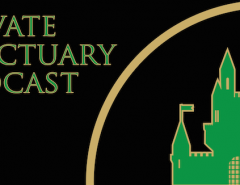Anthony Li and Alexander Augunas are talking homebrew with their second installment of Create Demiplane, a segment in which the Private Sanctuary Podcast’s Man Behind the Screens and Everyman Gamer talk about world building. If that wasn’t cool enough, they’ll be showing off the various strategies that they talk about each week by actually BUILDING a world to play in. (Specifically, a demiplane.)
In Create Demiplane’s latest installment, Alex and Anthony talk about the first thing in a setting that the PCs are likely to interact with: villages. We’ll be revealing the winner of the last You Decide and giving our listeners a new topic to vote on too!
Listen Now!
Create Demiplane Thus Far ….
A quick summary of our Demiplane after Episode 259.
“Subartic Plane” – Everything has been frozen over by ice and snow. No sunlight. Think Alaska in the dead of winter, year-round.
Major Deity — Codename “Flame Deity.” True Neutral. Major Deity. Has the following domains: Community, Healing, Fire, Protection, and SCALYKIN (You Decide winner!).
Settlements are “fueled” by dragons; their fire keeps the settlements running.
Primarily Red and Golds. Need mortals to build them shelters because red/gold dragons are vulnerable to gold and would eventually die without a place to retreat to.
Dragons are seen by mortals as avatars/children of the Major Fire Deity. Governments are theocracies with the settlement’s dragons acting as rulers.
New settlements are given an egg and a group of clerics to act as the wyrmling’s regents. The clerics have full power over the new settlement until the dragon reaches Adulthood (101 years).
Dragon flames provide heat and light for living, cooking, and growing food.
Silver and white dragons are in the setting; don’t know about other colors.
You Decide!
After listening to Episode 259, come back here and vote in the comments section about whether our dragons should have a static alignment (all reds/golds have X alignment unless manipulated otherwise by mortals) or they have a fluid alignment (dragons don’t have a particular alignment and are susceptible both to personal preferences and mortal machinations)?
Leave your votes in the comments, and we’ll build off of the winning side on the next Create Demiplane!
Podcast: Play in new window | Download





Even a wyrmling is CR 6, able to kill pretty much everyone in the village so while smaller than humans in the village would still be able to kill anyone who is not listening to their commands. Also I think a fluid alignment with a preference to their standard alignment.
That was the number! CR 6!
But yeah, I agree. Even a baby dragon could rip apart basically all of the clerics stationed there, and I like to imagine that the dragons don’t like putting too many high-level clerics in a village with their babies at a time; too risky that the clerics might be plotting something wicked. (I think that’s going to have to have happened somewhere at least once to be a justifiable fear, though.)
I would take a look at a couple of books. The D&D 4e metallic dragon Draconimicon talks about alignments and very non-human outlooks. (And Paizo actually does some work with that concept in Golarion, the island ruled by a gold dragon tyrant).
Dragon alignments have also been explicitly mutable in official D&D products for at least 11 years now. The dragons of Eberron have been decoupled from the color/alignment rules since it was first published. (I’d combine the two, mixed
I wouldn’t say that Hermea is ruled by a tyrant. Its more like a Marxist society.
Being mutable in Eberron doesn’t mean universally mutable, as Eberron was specifically designed to debunk many of D&D’s tropes. Take, for instance, cannibal halflings or jungle-dwelling drow for example.
Maybe make it be late teen dragons the first ones capable of supporting a village. That way dragons maintain a culture by passing it down among their descendants. It is a rite of passage for a young adult dragon to build or steal a human population. Some dragons work together to support larger towns as an uneasy council of wyrms.
I’m a big proponent of, “Children should be useful and part of the action,” in a world, and the imagery of handing an egg off to clerics to form a new village is too cool not to use. By the time they’re teenagers, a typical dragon has had a village for a while; I’ll have to look at the chart to figure out what the exact ages are for when a dragon can support each type of village.
Also you could have communities that bred dragons but lobotomize them at a certain point so they have the heat without the monster… Making themselves into monsters
Too graphic; I don’t like it. Charm and dominate spells are cool, but lobotomizing A) degrades the cool-factor of the dragon and B) removes any amount of risk that the subdued beast could become free, which is inherently less interesting for storytelling.
Don’t forget that CG Brass Dragons, CN Magma Dragons (Bestiary 2) and LE Underworld Dragons (Bestiary 3) also have fire breath weapons to keep villages warm. So you got options.
I forgot about Brass dragons and Underworld dragons. I didn’t forget about Magma dragons, but I personally think that they don’t work well for the symbiotic aspect we’re looking for. Maybe one city state run by a wizard managed to use a supped-up planar binding spell to trap a bunch of magma dragons on the demiplane to fuel his city….
Underworld Dragons would be interesting because it’s Lawful Evil. One example would be that it is there supporting the city because it knows that that is the best situation for itself. The people in the town have to keep him satisfied or he could leave. The dragon isn’t out to hurt anyone, it just only really cares about himself and will keep his end of the deal as long as towns people keep theirs.
For my vote to your question posed in the podcast, I’d choose the first option: Dragons have a natural tendency toward their listed alignment, but can be manipulated or convinced to do something different.
Anyone else getting really choppy audio? Love the podacast, but hard to listen to.
I vote for fluid alignments for the dragons.
Putting this out into the universe.
What if the city dragons were all females and the towns were part of their nests? When a dragon lays an egg, she becomes relatively vulnerable. So she gathers about her servants, Templars, to defend her against monsters, raiders, and other dragons while the egg incubates.
In addition, her dragon fire begins to permeate the surrounding landscape making it more arable. The area is small at first, but as the dragon ages, the area grows. As the area grows it becomes a more and more appealing target for rogue dragons, monsters, and raiders. Those Templars continue to have work to do.
Male dragons don’t have the ability to project their warmth to the same degree as female dragons. As a result they either do not develop towns around their lairs or, any that do develop are small. The towns of the male dragons tend to be either trade towns or havens for monsters or raiders.
I’d vote for fluid alignments, with a massive preference for their traditional alignments. You don’t want to go overboard with changing alignments (use the shock value of a evil metallic or a good chromatic).
Maybe the quest hook is a metallic dragon splinter kingdom being lead by a young (think teenage rebellious) corrupted/evil metallic dragon…and the other metallic dragons haven’t fully realised/ buried their head in the sand (being unwilling to believe the corrupted dragon has switched alignment).
Its a nice concept to explore that the shorter lived races can recognise the alignment change because they have seen members of their race changing alignments.
I think “always” alignments are silly. I vote for fluid alignments.
Alignment: If I were making the world I’d split the difference. Dragons are not set in alignment but most (60%) are their classic alignment and the majority (80%) are the same moral alignment. So most red dragons are CE and a few are NE or even LE depending on upbringing and a LN or even NG red dragon is possible, but rare.
Gender: Dragons don’t strike me as creatures that share power or play nice. I can’t see a mommy and daddy dragon working well together before ego gets in the way, even between good dragons.
If there were some gender control going on that might make for good stories. So the big dragon ruler has a monopoly on breeding and eggs.
It would work if all the wyrmlings of the opposite gender a killed except a couple breeders. But is a little… dark… for some people. It’d be fine if you want a really gritty setting though.
Making it natural might work better. Like the film Reign of Fire where most dragons are female and there are a few rare males. Having male dragons be rarer, smaller, and weaker works.
Kingdoms: The idea of multiple wyrm city-states might work better than kingdoms, as they’re smaller and more fluid. So you have the single metropolis ruled by the wyrmgod or really old dragon and a bunch of smaller satellite communities around it, most rules by blood-relative dragons.
This allows for more inter-kingdom conflict but also intra-kingdom conflict as the only way for a dragon to really rule would be to take out mommy and become queen.
And the head dragon might be aware and occasionally have to off a child and replace them with another (or a council of wyrms until one is big enough to run solo).
Just some random ideals I though I’d throw at you…
(Oh, and thanks for the plug.)
Great podcast! I was going to mention Eberron, but someone beat me to it. I do like the idea that dragons have fluid alignments, but tend towards their natural alignment. This opens up the possibility of good clerics manipulating a red or underworld dragon, and evil clerics manipulating a gold or brass dragon.
It also occurred to me that other dragons *could* exist in this world, but only at the whims of the fire dragons. A brass dragon stands to gain a lot from having bronze or copper allies living in the town, especially if it needs to defend against a marauding white dragon. Likewise, an evil black dragon might play the power-behind-the-throne to a red dragon, especially if that black dragon spends most of its time in human form.
About mining: The brass dragon has a burrow speed. If I were a gold dragon, I’d keep a few of them around to help my mining operations…
Food and mega-fauna: I don’t think that you can get mega-fauna in a permanently cold environment, unless they subsist on fish. On Paizo’s Crown of the World, there is lichen, which is eaten by bore-worms, which are eaten by “novosis—a flat-bodied, smooth-skinned amphibian that burrows through the soft snow, grinding the surface ice with bony mandibles and sucking bore-worms into its gullet.” The novosis seems to replace the arctic hare in the food chain, making it possible for other predators to exist. (On Earth, the hare is a big deal: it doesn’t eat much, but small plants grow from its feces, and hares are food for everything from foxes to owls to humans. Novosis seem to fill that role on Golarion.) Anyway, if you don’t have a tundra, you don’t have mega-herbavores like giant elk, mastodons, or woolly rhinos (which is sad, because I love woolly rhinos). They could be kept by humans as herd animals, but the humans would have to find a way to feed them, as well. There might be winter wolves, but I imagine they’d hunt humans.
Greenhouses are great, but what about underground agriculture? I imagine the mushroom farming would be big, and root vegetables were a huge deal for vikings, since they’ll grow under the snow with just a little bit of sun.
I think that your big food source is going to be humans, themselves, though. Not cannibalism, though you shouldn’t rule it out, but clerics. Clerics can cast “create food and water,” and if you build a “create food and water” “trap”, your village survives, and doesn’t need farming, at all. If you build one big enough, you can feed your herd animals. On the one hand, this takes care of the food problems (which might be boring), but on the other it makes clerics (and druids) even more important. It also provides political leverage: if I’m the cleric, and I control the food “trap,” then the rest of the village had better do what I say. This also leaves the door open for “rebel cells” led by druids, in evil dragon kingdoms. They can survive outside the dragonholds, but only if they stay close enough to the druid to get their daily “endure elements” and “create food.”
Other spells that might make life possible: Daylight: a lot of taiga flora can grow just fine with an hour of light a day. Plant growth: obviously. Control Winds/ Weather. Wall of Fire + Permanency (cast that around an area, combine with daylight + permanency, and you just built a greenhouse). There must be others, but I’m blanking on them, right now.
One other thing: anyone who’s done arctic camping can tell you that the warmest place to sleep is in a hole under the snow. That might leave open the option of “buried kings”: powerful dragons or other immortals (fey, norns, high-level monks) who wrapped themselves in snow, but can be dug out if needed.
How about, instead of making alignment based on the colour of the dragon. Make the colour of the scales adapt to the behaviour of the dragon.
The more evil the dragon is the more red and less metallic its scales become.
That way you can have the dragon behave in any way the GM likes without being pushed into a Good/Evil stereotype based entirely on its lineage.
Maybe a dragon can change its scales after all.
Well, a dragon that can breathe electricity would have problems with it, but lightning can technically light something on fire to get the fires going… they could be able to be mobile, like if someone managed to start a buisness, they could have/work with a lightning dragon.
that being said. on the other chromatics and metallics like acid, they are still big monsters, a lot have magic, so they could endure elements or get a step up and cold resistance themselves, so the bigger ones might not have died out, so as they pass on in time, only the MASSIVE ones would still be around. perhaps hidden away, they might have been smart when the freezes came and settled in hot places like hydrothermal vents in the ocean or near a volcano.
places like those tend to be very fertile so they could have pockets of insanely fruitful land. People could go out to those places out of either greed or necessity. There’s an adventure hook right there!
As I was listening to this (long after it was recorded) I kept thinking:
Gold = LG
Red = LE
Silver = CG
White = CE
The lawful ones work with humans, the chaotic ones fend for themselves. The good ones are friendly, the evil ones monsterous.
Rather than have dragon alignments themselves be fluid, I’d say that all four colors can hatch from the same clutch of eggs. And all dragons would want to see their children live, regardless of color. So a red dragon may never understand its silver child, but it will kick it out of the nest to fend in the wilderness rather than kill it.
I would also like to offer the idea of Dragonwood. Plants don’t grow well in (The Demiplane), but Dragonwood does. There’s one type for each element named after the dragon gods of the realm. Fire Dragonwood (Ixenwood) might be soft and catch fire easy but burns for a long time. Good for keeping things warm. Earth Dragonwood (Edarwood) would be sturdy and strong. Good for making all kinds of things. Air Dragonwood (Thraewood) is light and flexible. Particularly prized by elves. Used for sleighs and bows and arrows. Ice Dragonwood (Xarwood) is the most common. Its the standard wood for everything.